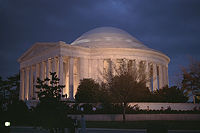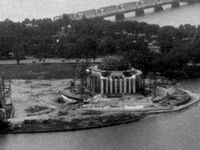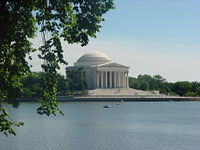Jefferson Memorial
 From Nwe
From Nwe | Thomas Jefferson Memorial | |
|---|---|

|
|
| Location: | Washington, D.C., United States |
| Area: | 18.36 acres (74,300 meters²) |
| Established: | April 13, 1943 |
| Visitation: | 2,312,726 (in 2005) |
| Governing body: | National Park Service |
The Thomas Jefferson Memorial is a presidential memorial in Washington, D.C. that is dedicated to Thomas Jefferson, an American Founding Father and the third president of the United States.
The neoclassical building was designed by John Russell Pope and completed in 1943. The memorial itself is composed of marble steps, a dome and a portico. The open-air building is in West Potomac Park, on the south shore of the Tidal Basin of the Potomac River. It is one of the main points in the area of the National Mall in the District of Columbia, forming a line with the Washington Monument and the White House. The Jefferson Memorial is managed by the National Park Service under its National Mall and Memorial Parks division.
History

President Franklin Roosevelt proposed a monument for Thomas Jefferson. There were monuments in Washington commemorating great United States presidents by the 1930s. On June 26, 1934, Congress passed a resolution to create a monument commemorating Jefferson.
The memorial was designed by John Russell Pope, who was also the architect of the original (west) building of the National Gallery of Art. The memorial's structure reflects characteristics of buildings designed by Jefferson such as his home, Monticello, and the Rotunda. Elements of Monticello and the Rotunda reflected his fascination with Roman architecture. The Jefferson Memorial bears some resemblance to the Pantheon of Rome.
Construction

The cornerstone of the Memorial was laid on November 15, 1939. Daniel P. Higgins and Otto R. Eggers took over construction of the memorial as Pope had died two years earlier. The memorial was constructed with Vermont Danby Imperial marble for the exterior walls and columns and Tennessee pink marble was used for the interior floor. Georgian white marble was used for the interior wall panels, and Missouri gray marble for the pedestal. Indiana limestone was used in construction of the ceiling. The cost of construction was slightly more than $3 million.
The Jefferson Memorial was officially dedicated on April 13, 1943—the 200th anniversary of Jefferson's birth. It is one of the last American public monuments constructed in the Beaux-Arts tradition. The memorial was severely criticized even as it was being built. Adherents to the modernist argument believed that dressing twentieth century buildings like Greek and Roman temples constituted a "tired architectural lie." More than 60 years ago, Pope responded with silence to critics who dismissed him as part of an enervated architectural elite practicing "styles that are safely dead." As a National Memorial, it was administratively listed on the National Register of Historic Places on October 15, 1966.
Interior
The interior of the memorial has a 19-foot (5.8 meters) tall, 10,000-pound (5 tons) bronze statue of Jefferson by sculptor Rudulph Evans. The interior walls are engraved with passages from Jefferson's writings. Most prominent are the words which are inscribed around the monument near the roof: "I have sworn upon the altar of God eternal hostility against every form of tyranny over the mind of man." This sentence is taken from a September 23, 1800 letter by Jefferson to Dr. Benjamin Rush.
The 129-foot (39 meters) dome is four feet (1.2 meters) thick and the memorial weighs 32,000 short tons (29,000 metric tons). The sculpture in the pediment was created by Adolph Alexander Weinman.
Location

The Jefferson Memorial is located in Washington, D.C.’s West Potomac Park on the shore of the Potomac River Tidal Basin. The view is enhanced with the massed planting of Japanese cherry trees, which were a gift from the people of Japan in 1912.
The monument is not as prominent in popular culture as other Washington, D.C. buildings and monuments, possibly due to its location well removed from the National Mall and the Washington Metro transportation system.
The Jefferson Memorial hosts many events and ceremonies each year, including memorial exercises, the Easter Sunrise Service, and the annual National Cherry Blossom Festival.
Interior Inscriptions
| Encircling the cupola: I have sworn upon the altar of God eternal hostility against every form of tyranny over the mind of man. | |
Taken from a letter to Dr. Benjamin Rush, September 23, 1800. Almighty God hath created the mind free…All attempts to influence it by temporal punishments or burthens…are a departure from the plan of the Holy Author of our religion…No man shall be compelled to frequent or support any religious worship or ministry or shall otherwise suffer on account of his religious opinions or belief, but all men shall be free to profess and by argument to maintain, their opinions in matters of religion. I know but one code of morality for men whether acting singly or collectively. |
Taken from the Declaration of Independence, 1776. We hold these truths to be self-evident that all men are created equal, that they are endowed by their Creator with certain inalienable rights, among these are life, liberty, and the pursuit of happiness, that to secure these rights governments are instituted among men. We...solemnly publish and declare, that these colonies are and of right ought to be free and independent states...And for the support of this declaration, with a firm reliance on the protection of divine providence, we mutually pledge our lives, our fortunes, and our sacred honor. |
Taken from A Bill for Establishing Religious Freedom, 1777. The last sentence is taken from a letter to James Madison, August 28, 1789. God who gave us life gave us liberty. Can the liberties of a nation be secure when we have removed a conviction that these liberties are the gift of God? Indeed I tremble for my country when I reflect that God is just, that his justice cannot sleep forever. Commerce between master and slave is despotism. Nothing is more certainly written in the book of fate than these people are to be free. Establish the law for educating the common people. This it is the business of the state to effect and on a general plan. |
Taken from a letter to Samuel Kercheval, July 12, 1810 I am not an advocate for frequent changes in laws and constitutions, but laws and institutions must go hand in hand with the progress of the human mind. As that becomes more developed, more enlightened, as new discoveries are made, new truths discovered and manners and opinions change, with the change of circumstances, institutions must advance also to keep pace with the times. We might as well require a man to wear still the coat which fitted him when a boy as civilized society to remain ever under the regimen of their barbarous ancestors. |
References
ISBN links support NWE through referral fees
- Bedford, Steven McLeod. John Russell Pope: Architect of Empire. New York: Rizzoli International Publications, Inc., 1998. ISBN 9780847820863
- Goode, James M. The Outdoor Sculpture of Washington D.C. Washington, DC: Smithsonian Institute Press, 1974. ISBN 9780874741384
- The National Parks: Index 2001–2003. Washington, DC: U.S. Department of the Interior.
External links
All links retrieved July 30, 2022.
- Thomas Jefferson Memorial – National Park Service
- Quotations on the Jefferson Memorial – Thomas Jefferson Foundation
Credits
New World Encyclopedia writers and editors rewrote and completed the Wikipedia article in accordance with New World Encyclopedia standards. This article abides by terms of the Creative Commons CC-by-sa 3.0 License (CC-by-sa), which may be used and disseminated with proper attribution. Credit is due under the terms of this license that can reference both the New World Encyclopedia contributors and the selfless volunteer contributors of the Wikimedia Foundation. To cite this article click here for a list of acceptable citing formats.The history of earlier contributions by wikipedians is accessible to researchers here:
- Jefferson Memorial history
The history of this article since it was imported to New World Encyclopedia:
- History of "Jefferson Memorial"
Note: Some restrictions may apply to use of individual images which are separately licensed.
↧ Download as ZWI file | Last modified: 02/03/2023 20:26:13 | 4 views
☰ Source: https://www.newworldencyclopedia.org/entry/Jefferson_Memorial | License: CC BY-SA 3.0
 ZWI signed:
ZWI signed: KSF
KSF